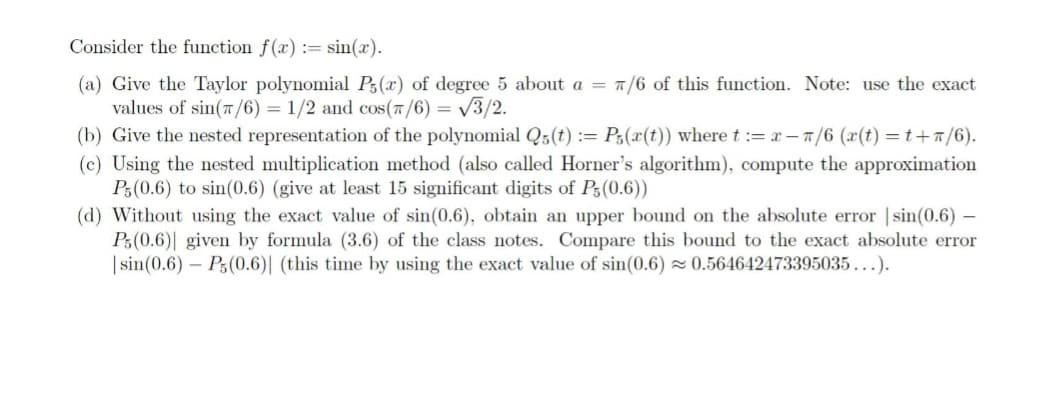Consider the function f(x) = sin(x). (a) Give the Taylor polynomial Ps(x) of degree 5 about a = π/6 of this function. Note: use the exact values of sin(7/6)= 1/2 and cos(7/6)= √3/2. (b) Give the nested representation of the polynomial Q5(t) = P₁(x(t)) where t :=x-7/6 (x(t)=t+π/6). (c) Using the nested multiplication method (also called Horner's algorithm), compute the approximation P(0.6) to sin(0.6) (give at least 15 significant digits of P3 (0.6))
Consider the function f(x) = sin(x). (a) Give the Taylor polynomial Ps(x) of degree 5 about a = π/6 of this function. Note: use the exact values of sin(7/6)= 1/2 and cos(7/6)= √3/2. (b) Give the nested representation of the polynomial Q5(t) = P₁(x(t)) where t :=x-7/6 (x(t)=t+π/6). (c) Using the nested multiplication method (also called Horner's algorithm), compute the approximation P(0.6) to sin(0.6) (give at least 15 significant digits of P3 (0.6))
Advanced Engineering Mathematics
10th Edition
ISBN:9780470458365
Author:Erwin Kreyszig
Publisher:Erwin Kreyszig
Chapter2: Second-order Linear Odes
Section: Chapter Questions
Problem 1RQ
Related questions
Question
Plz solve within 60min min I vill upvote and vill give positive feedback thank you
But be quick

Transcribed Image Text:Consider the function f(x) = sin(x).
(a) Give the Taylor polynomial P(x) of degree 5 about a = π/6 of this function. Note: use the exact
values of sin(7/6)= 1/2 and cos(π/6)= √3/2.
(b) Give the nested representation of the polynomial Q5 (t) = P5(r(t)) where t :=x-/6 (x(t)=t+n/6).
(c) Using the nested multiplication method (also called Horner's algorithm), compute the approximation
P5(0.6) to sin(0.6) (give at least 15 significant digits of P5(0.6))
(d) Without using the exact value of sin(0.6), obtain an upper bound on the absolute error sin(0.6) -
P5(0.6) given by formula (3.6) of the class notes. Compare this bound to the exact absolute error
| sin(0.6) P5(0.6) (this time by using the exact value of sin(0.6)≈ 0.564642473395035...).
Expert Solution
This question has been solved!
Explore an expertly crafted, step-by-step solution for a thorough understanding of key concepts.
Step by step
Solved in 4 steps with 4 images

Recommended textbooks for you

Advanced Engineering Mathematics
Advanced Math
ISBN:
9780470458365
Author:
Erwin Kreyszig
Publisher:
Wiley, John & Sons, Incorporated

Numerical Methods for Engineers
Advanced Math
ISBN:
9780073397924
Author:
Steven C. Chapra Dr., Raymond P. Canale
Publisher:
McGraw-Hill Education

Introductory Mathematics for Engineering Applicat…
Advanced Math
ISBN:
9781118141809
Author:
Nathan Klingbeil
Publisher:
WILEY

Advanced Engineering Mathematics
Advanced Math
ISBN:
9780470458365
Author:
Erwin Kreyszig
Publisher:
Wiley, John & Sons, Incorporated

Numerical Methods for Engineers
Advanced Math
ISBN:
9780073397924
Author:
Steven C. Chapra Dr., Raymond P. Canale
Publisher:
McGraw-Hill Education

Introductory Mathematics for Engineering Applicat…
Advanced Math
ISBN:
9781118141809
Author:
Nathan Klingbeil
Publisher:
WILEY

Mathematics For Machine Technology
Advanced Math
ISBN:
9781337798310
Author:
Peterson, John.
Publisher:
Cengage Learning,

